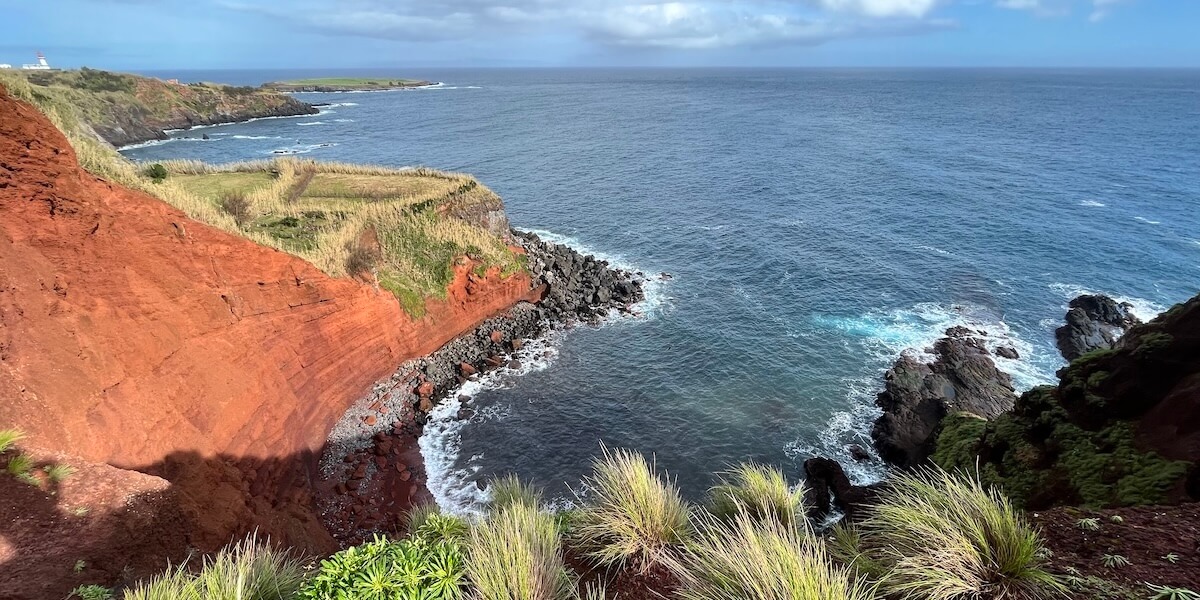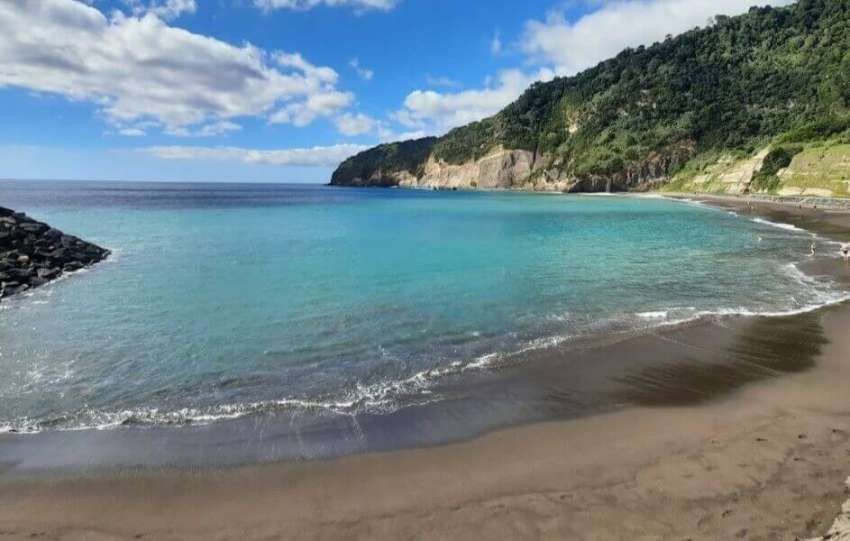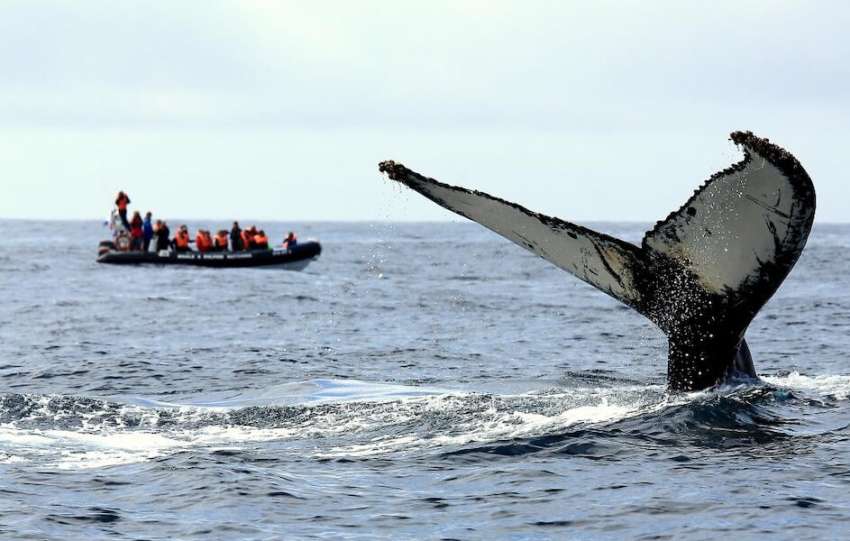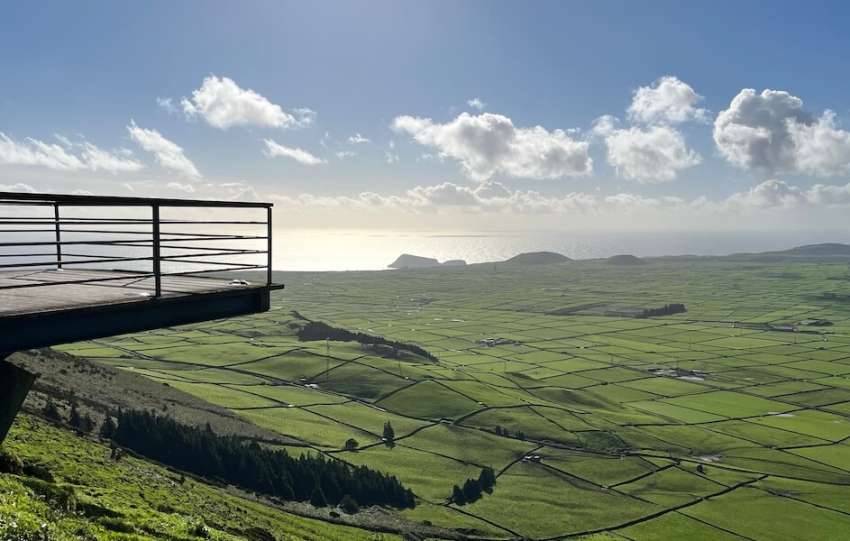Share This Article
Natural wonders in the Azores are everywhere you look — from steaming volcanic craters and jungle-covered hot springs to epic crater lakes, waterfalls, and underwater caves. But where do you even start? In this guide, I take you island by island through the most breathtaking places to hike, swim, soak, and just stand there in awe.
No time for a long article? Here’s a summary
This is my personal, and very much tested, list of the best Natural wonders in the Azores per island:
- São Miguel Island: Kayaking in Sete Cidades lake, visit the Furnas village (it’s magic!) and do a night tour of its hot springs, Kayak to Vila Franca do Campo Islet and swim in a volcanic crater and, of course, go whale and dolphin watching.
- Terceira island: Algar do Carvão and Gruta do Natal are both stunning and VERY unique. Serra do Cume is stunning!
- Pico island: Climbing Mount Pico is the most amazing experience. It is also one of the best islands to go whale watching.
- Flores & Corvo: Poço da Ribeira do Ferreiro, the natural pool of Santa Cruz das Flores and, obviously, you need to visit Corvo island on a day trip from Flores.
- Faial island: definitely the Capelinhos vulcano (the museum is pretty good too), and descend the Faial cratera. It’s quite expensive though.
- São Jorge: hike to as many Fajãs as possible and make sure to visit the peaks – they are often overlooked!
Keep reading for more honest, down to Earth information about the natural wonders in the Azores!
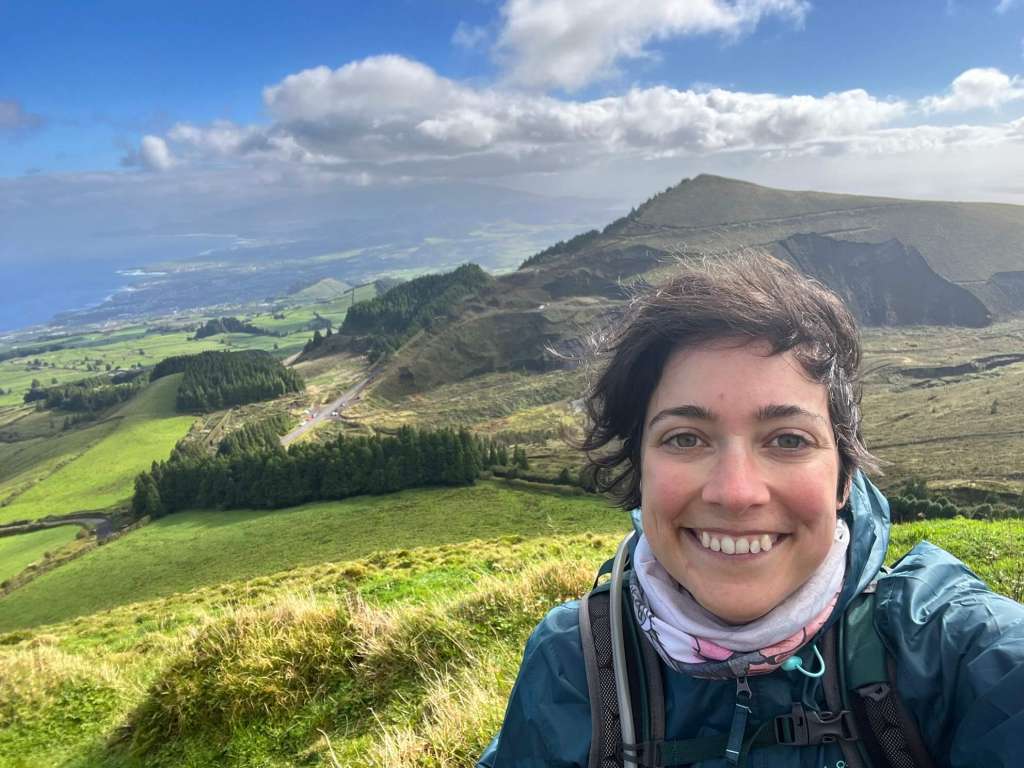
Natural Wonders in São Miguel Island
If the Azores were a family, São Miguel would be the charismatic eldest sibling who’s good at everything: dramatic views, lush forests, steaming hot springs, and even a charming way of making you feel like you’re in the middle of a prehistoric movie set. It’s the most visited island for a reason — many of the most iconic natural wonders in the Azores are right here, all within a couple hours’ drive.
Sete Cidades: the ultimate Postcard of the Azores
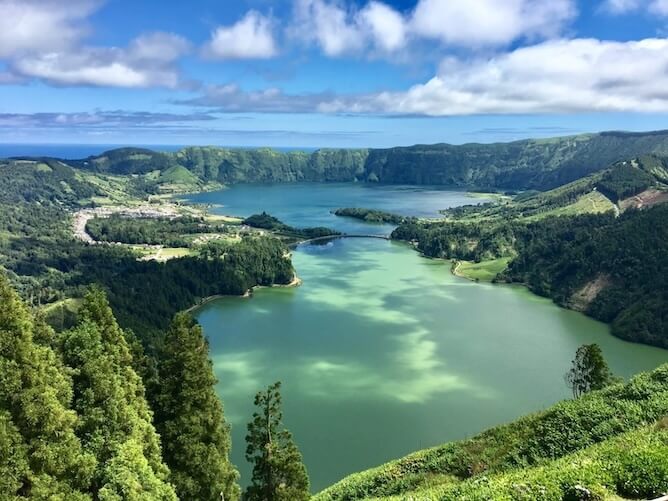
Sete Cidades is the crown jewel of São Miguel — and quite possibly the entire archipelago. You’ve probably seen the classic photo from Miradouro da Vista do Rei: two crater lakes, one green and one blue, nestled inside a volcanic caldera. But no photo really does it justice. Standing there in person, it feels like nature just casually dropped a masterpiece.
That said, one of the best ways to truly feel the scale of this place is not from above, but on the water. Renting a kayak and paddling across the lake is peaceful, surreal, and just the right amount of adventurous — no experience required, just a willingness to float through one of the most beautiful places in Portugal.
👉 Rent a kayak and explore Sete Cidades from the water
Furnas Valley: Volcanic Vibes and Steamy Delights

Furnas is the heart of São Miguel’s geothermal magic — a village where the ground steams, the food cooks underground, and soaking in thermal pools is basically a daily ritual. You can smell the volcanic activity before you see it (in a good way), and there’s something really grounding about walking among bubbling mud pots and mineral-rich springs.
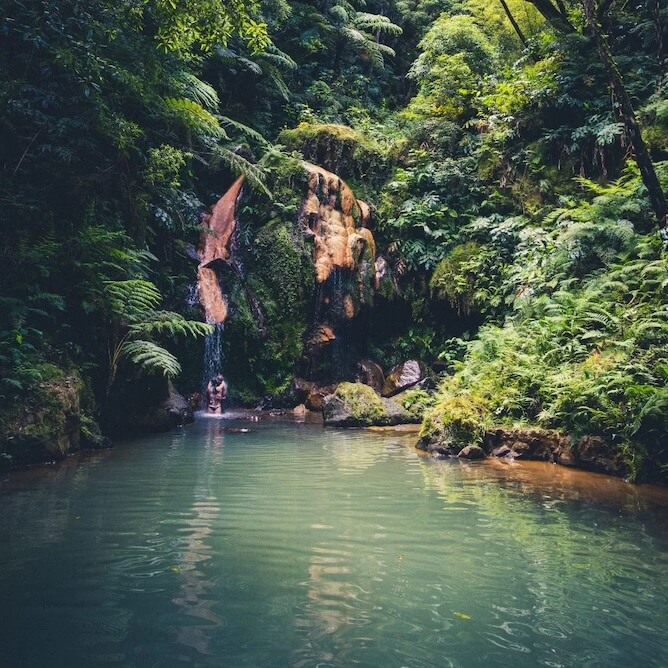
After a stroll through the gardens of Terra Nostra Park or a peek into the steaming fumaroles at Lagoa das Furnas, the best way to end your day is with a dip in one of the many hot springs — preferably after dark, when everything gets quiet and magical. This night-time tour is a personal favorite as it includes the famous Cozido das Furnas dinner and a night dive on the most beautiful hot springs in São Miguel island.
👉 Soak under the stars and dine on volcano-cooked stew
Vila Franca do Campo Islet: Swim in a Volcano (Yes, really)

Just off São Miguel’s south coast, this tiny volcanic islet is a real-life “how is this place even real?” kind of location. The crater collapsed in just the right way to create a nearly perfect circular lagoon, now a protected marine reserve with some of the clearest water you’ll swim in.
In summer, small boats ferry visitors out from Vila Franca do Campo. In the summer, it’s accessible by boat — or, if you’re feeling a little more adventurous, by kayak. It’s the kind of experience you’ll talk about for months, mostly by saying, “Did I tell you we swam in a volcano?”
👉 Kayak to Vila Franca do Campo Islet and swim in a volcanic crater
Whale & Dolphin Watching: Ocean Giants, Up Close
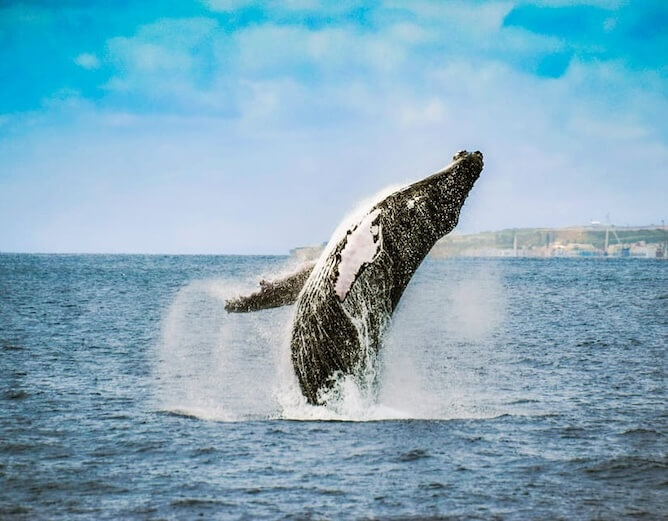
If there’s one experience that reminds you how wild and alive the Azores really are, it’s whale watching. São Miguel is one of the best islands to see sperm whales, pilot whales, and playful dolphins — and you don’t have to go far offshore. The tours leave straight from Ponta Delgada and often spot marine life within minutes.
The guides are marine biologists (so yes, you’ll actually learn things), and the thrill of spotting a fin or tail in the Atlantic never gets old. Even on days when the whales play hard to get, the boat ride alone is worth it. Still, I’d recommend this activity from April to October.
👉 Book a 3-hour whale and dolphin watching trip from Ponta Delgada
🎒 Want even more splashy fun? Read: Top Water Activities in São Miguel
🛏️ Planning your base camp? Here’s my no-nonsense guide to where to stay in São Miguel
Natural Wonders in Terceira Island
Terceira is one of the most popular islands in the Azores — and for good reason. It’s got everything: dramatic viewpoints, volcanic caves, natural pools, and a historic city that’s also a UNESCO World Heritage Site (Angra do Heroísmo). It is super easy to get to Terceira island, the infrastructure is there BUT that doesn’t mean the natural wonders in the Azores feel any less magical :)
Algar do Carvão: A volcanic cathedral
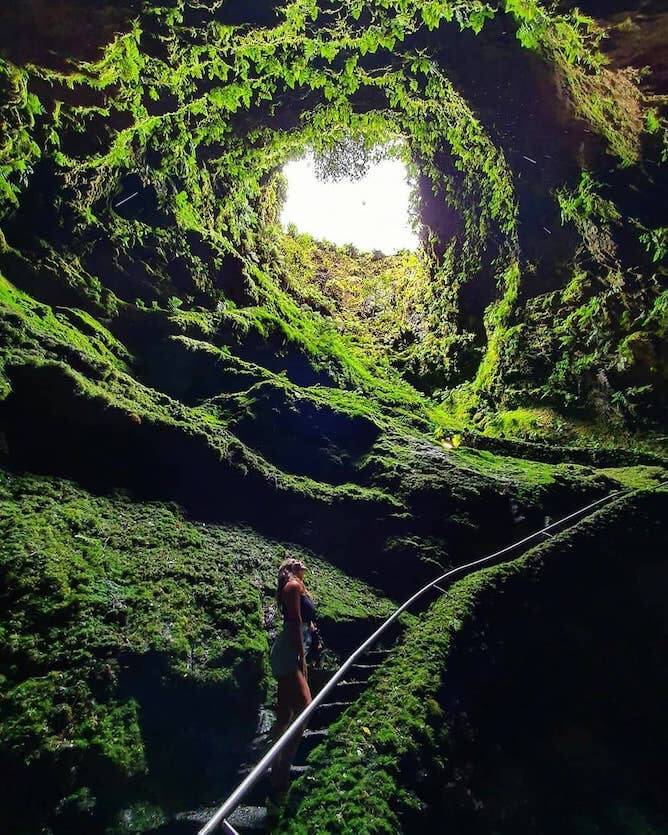
You don’t just visit Algar do Carvão — you descend into it. This incredible vertical lava tube takes you deep inside the Earth, where dripping stalactites and moss-covered walls make it feel more like a lost temple than a cave. At the bottom, a perfectly still lake reflects the light from above, and the silence is almost sacred.
Now, full transparency: I loved this place, but I definitely felt I would’ve gotten so much more out of it with a proper guide. The geology, the lava formations, even the story behind the name — there’s a lot to take in, and a tour makes it all come alive. This is why I recommend you to Explore Algar do Carvão and nearby caves with a local guide – otherwise you’d be just taking random pictures for your Instagram!
Gruta do Natal: Terceira’s Underground History
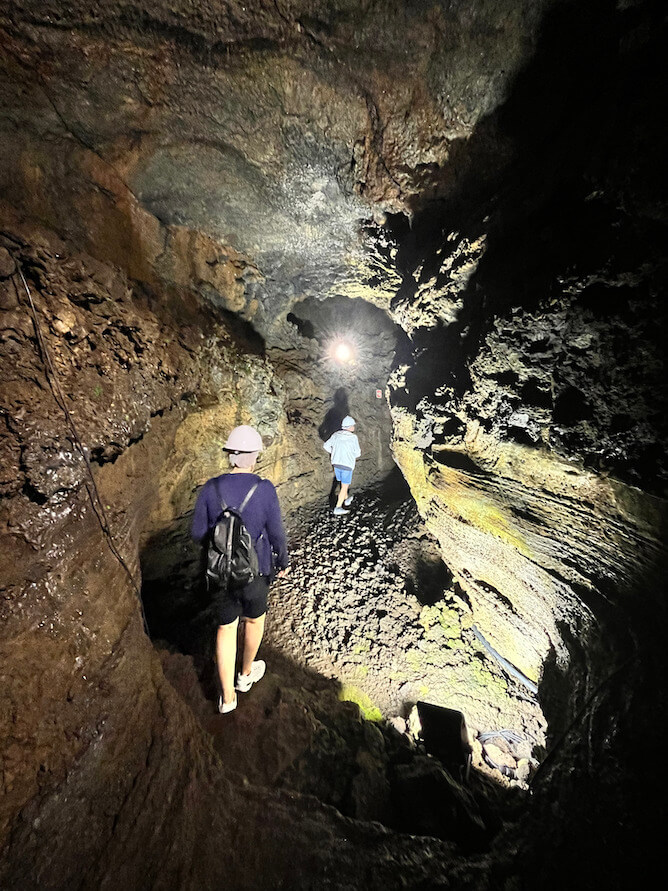
Right nearby, you’ll find Gruta do Natal, another volcanic cave formed thousands of years ago by flowing lava. It’s part of a wider network of lava tubes on the island, and while it’s less jaw-dropping than Algar do Carvão, it’s still absolutely worth a visit — especially if you’re into geology, photography, or just the idea of walking where fire once flowed.
You’ll get a helmet at the entrance, and from there, it’s an easy self-guided walk through a fascinating piece of Terceira’s volcanic past. I’ve really enjoyed it and I think you might too!
Serra do Cume: The most perfect viewpoint
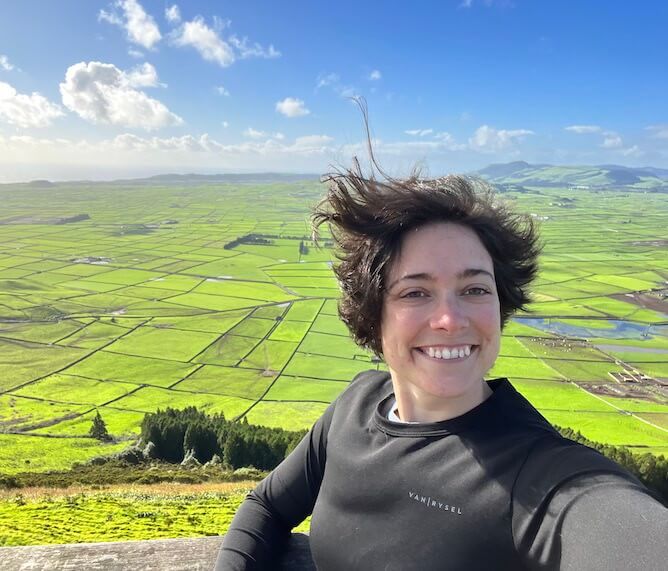
Serra do Cume is home to one of my all-time favorite views in the Azores. From the top, you’ll see a massive green quilt of fields — neatly squared off and framed by stone walls — stretching all the way to the ocean. On a clear day, you can see both sides of the island, which makes this one of the best panoramic viewpoints anywhere in the archipelago.
It’s especially striking in the early morning, when the mist is still lifting and the light is soft. If it is a very windy day you might want to skip it, so that your hair doesn’t look as ridiculous as mine :P
Biscoitos & Porto Martins’ Natural Pools
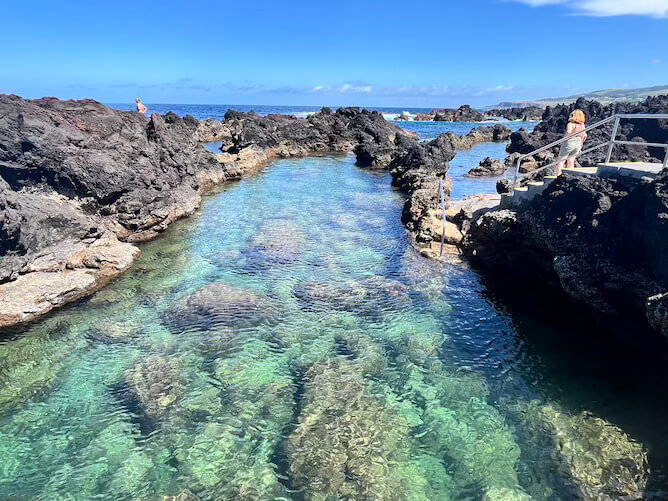
When the sun’s out, the locals head to Biscoitos — a cluster of volcanic rock pools carved by nature and tamed just enough for swimming. The water is crystal clear and refreshingly cold, but once you’re in, you’ll never want to leave. There are platforms to sunbathe on, ladders for easy access, and usually a friendly mix of locals and visitors sharing the space.
If you want something gentler, Porto Martins is another great option. The natural pools here are calmer and shallower, perfect for kids or anyone just looking to float around in a volcanic bathtub.
🛏️ Staying a few days? Here’s where to stay in Terceira — from city vibes to quiet countryside escapes.
Natural Wonders in Pico Island
Pico is rugged, dramatic, and unshakably proud of its volcanic roots. You’ll find black basalt coastlines, ancient lava flows, and UNESCO-listed vineyards framed by stone walls. But what really makes this island special isn’t just how raw the landscape is — it’s how it constantly reminds you that you’re walking on a volcano. Some of the most awe-inspiring natural wonders in the Azores live here, and they’re not shy about showing off.
Mount Pico: A Summit You’ll Never Forget
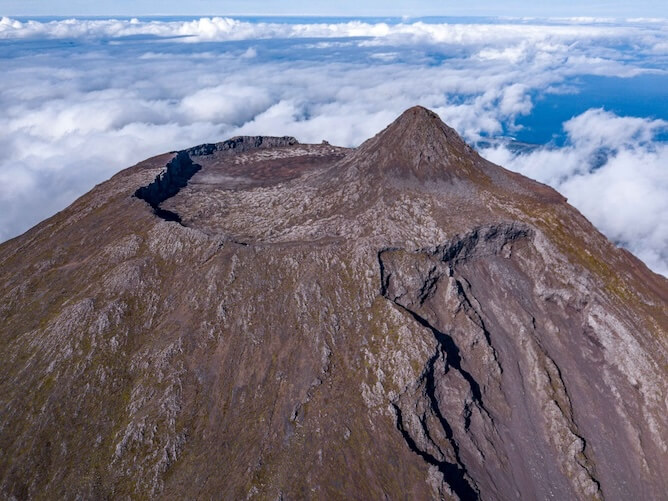
At 2,351 meters, Mount Pico is the highest point in all of Portugal — and climbing it is no joke. The hike is steep, the terrain is rocky, and the weather at the summit changes faster than your phone can update its forecast. But if you’re up for the challenge, it’s absolutely unforgettable.
I’m not going to lie: it’s tough. You’ll need proper gear, good shoes, and ideally a guide (which is legally required at night or for descents from the crater). But standing on the summit at sunrise, above the clouds, with views of Faial and São Jorge in the distance? You’ll never look at a mountain the same way again.
These days it is no longer possible to hike to Mount Pico on your own, so make sure to book your Climb Mount Pico with a certified guide.
Whale Watching in Pico island
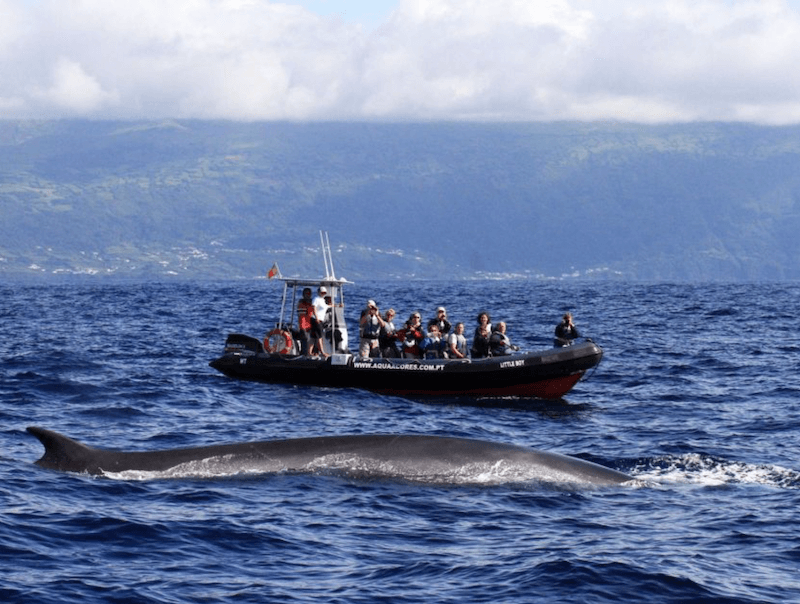
Pico’s connection to whales goes way back — this used to be a whaling island, and you can still see traces of that history in the harbors and its two modest (yet super interesting) whaling museums. Thankfully, today it’s all about observation, not harpoons — and the waters around Pico are some of the best in the world for spotting whales and dolphins.
Whether you’re watching sperm whales (resident year-round), pilot whales, or seasonal visitors like blue and fin whales, the experience is pure magic. The guides are knowledgeable, respectful of the animals, and deeply connected to the island’s maritime roots.
👉 Book a whale & dolphin watching boat tour from Pico
UNESCO Vineyards: Wines grown in Lava
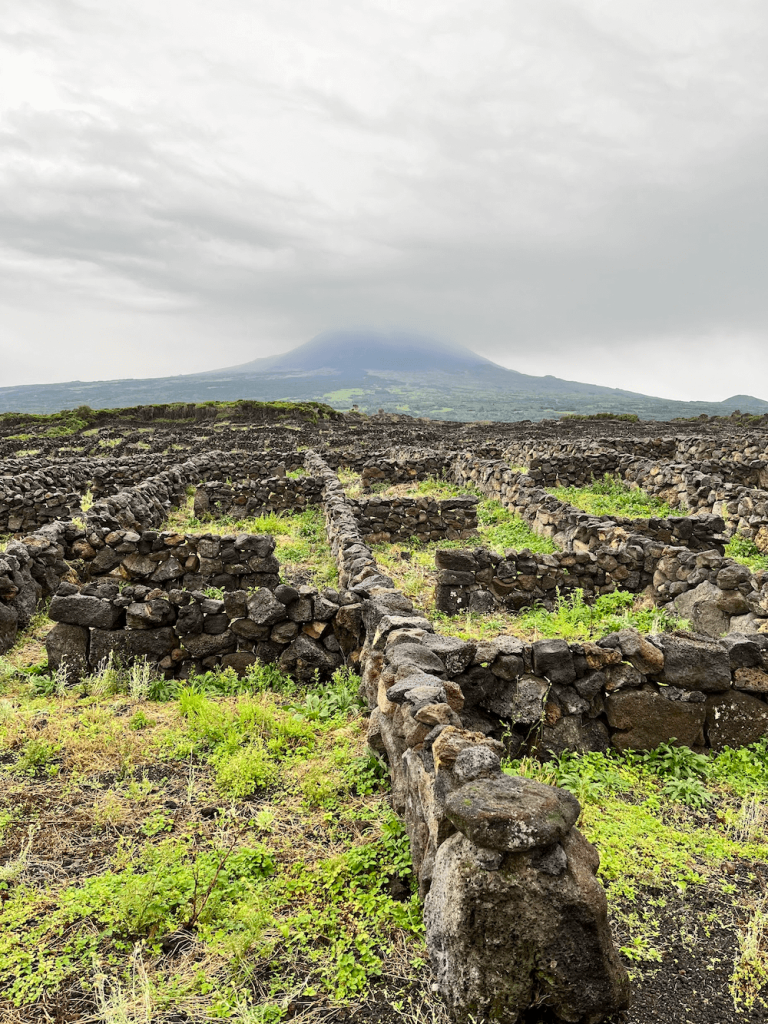
It’s not every day you sip white wine made from vines that grow in cracks between black lava stones. But that’s exactly what happens in Pico’s vineyard landscape, a UNESCO World Heritage Site that looks like no other wine region in the world.
The stone walls (called currais) protect the vines from wind and sea spray, and the resulting wines — especially the dry whites — are crisp, minerally, and unlike anything you’ve tried before. Even if you’re not a wine person, walking through the vineyards and hearing the history behind them is fascinating.
🍷 Curious? Here’s my full guide to wine tasting in Pico Island.
🛏️ Staying a while? Here’s where to stay in Pico Island — whether you want mountain views or beachfront breakfasts.
Natural Wonders in Faial Island
Faial is where nature reminds you just how powerful it really is. From the ash-covered moonscape of Capelinhos to the lush green interior and massive caldera at its heart, this island feels like a masterclass in volcanic contrast. It’s a small, vibrant island where the natural wonders in the Azores meet the vibrant vibe of Horta city.
Capelinhos Volcano
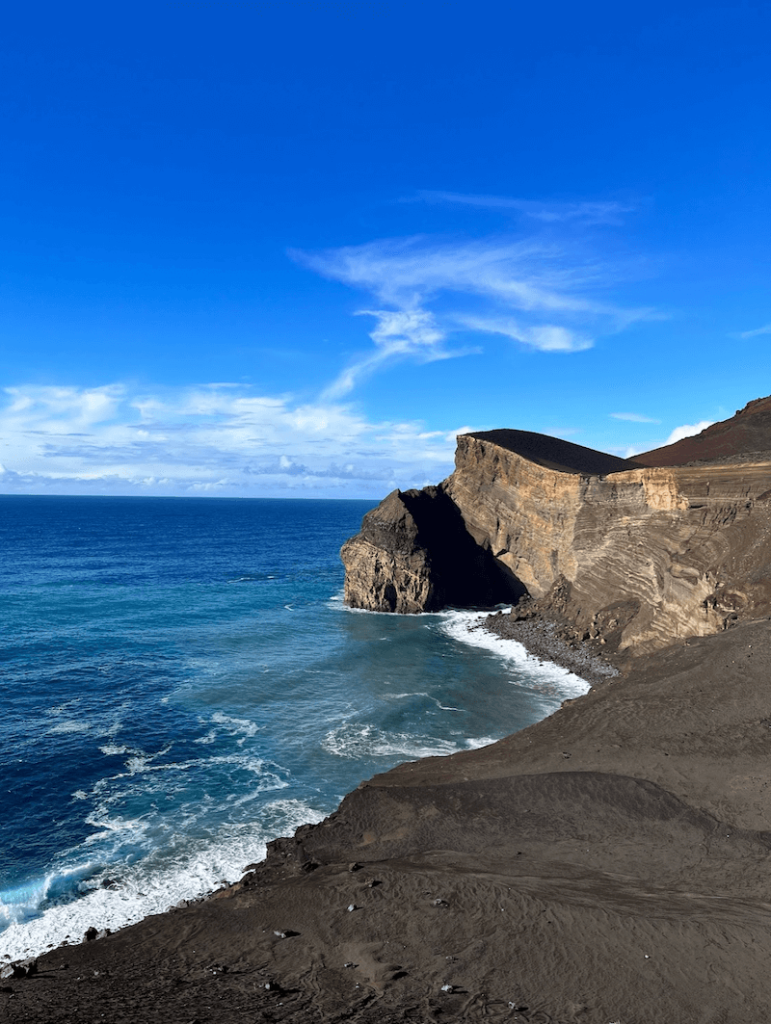
In 1957, the western tip of Faial exploded. Literally – for 13 months, volcanic eruptions transformed the coastline, created an entirely new piece of land, and blanketed everything in ash. The result? One of the most dramatic natural wonders in the Azores — a raw, barren, almost lunar landscape that’s unlike anything else in the archipelago.
There’s a quiet, eerie beauty here. You can walk over the volcanic debris, stand where the old lighthouse was half-buried, and then step inside the Capelinhos Interpretation Center, which is brilliantly done. It tells the story of the eruption, the families who left, and how the island rebuilt itself — all underground, hidden from the landscape it explains. I don’t recommend you to visit it on a windy day though – the short walk back the car park is going to be a nightmare.
🧭 Want to go deeper? Check the Faial’s volcanic history if you’re into geology.
Faial Caldera: a unique ecosystem in the Azores
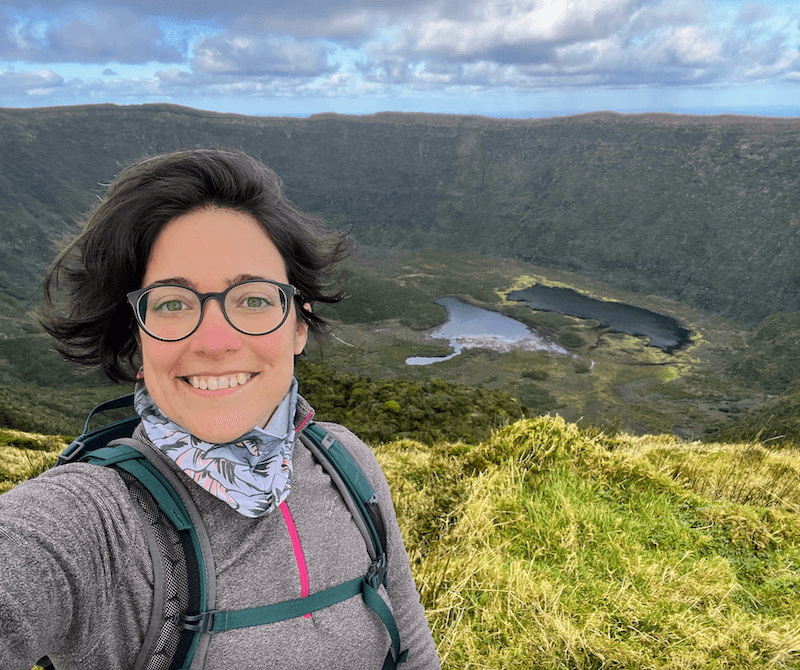
In the center of the island lies Caldeira do Faial, a massive volcanic crater surrounded by misty forest and steep ridges. The view from the top is worth the drive alone — especially on a clear day when the clouds roll in and out like a slow-motion time-lapse. You can even circle around it on a pleasant hike.
However, descending into the caldera (with a licensed guide, as required by the law), is something else entirely.
Inside, it’s pure Jurassic Park energy: ferns, moss, rare birds, and total silence except for your footsteps. It’s one of those unique ecosystems where you feel completely disconnected from the outside world — in the best way.
Natural Wonders in São Jorge Island
São Jorge is long, narrow, and completely unforgettable. Unlike the more urban feel of Terceira or São Miguel, this island feels like one continuous viewpoint — cliffs, forests, and the sea below follow you everywhere. If you’re looking for natural wonders in the Azores that blend drama and calm, São Jorge nails it. It’s a place where the hikes are rewarding, the views are cinematic, and its population is the nicest in the entire Azores archipelago. True story :)
Fajã da Caldeira de Santo Cristo
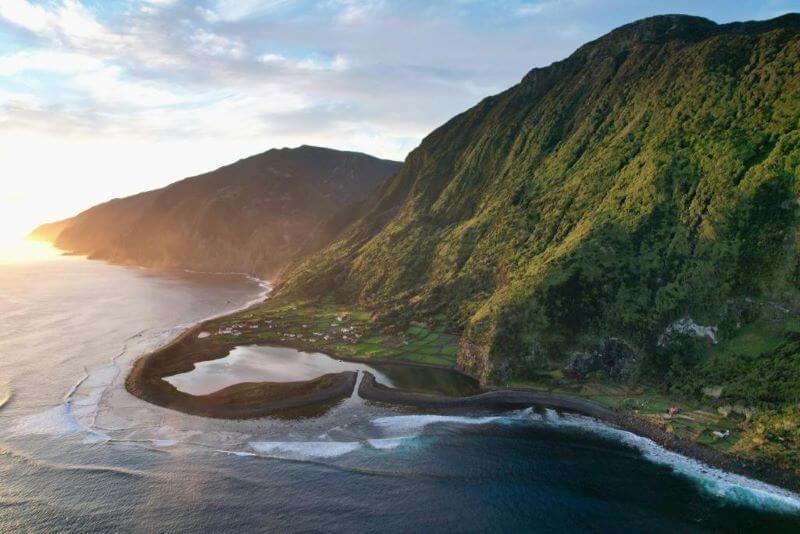
There’s something almost spiritual about the hike to Fajã da Caldeira de Santo Cristo. You start high in the hills, walking through a forested path with glimpses of the ocean far below. Then suddenly, the trees open up, and you arrive in this tranquil, flat stretch of land — hemmed in by cliffs on one side and the Atlantic on the other.
The lagoon here is calm and shallow, with soft black sand lining its edge. There are no cars and barely any signal. What you do find is silence, a small chapel, a few stone houses, and the Atlantic stretching endlessly in front of you.
What makes it truly unique? The clams — this is the only place in the Azores where they grow naturally, and locals still come here to harvest them the traditional way.
The Central Peaks of São Jorge island
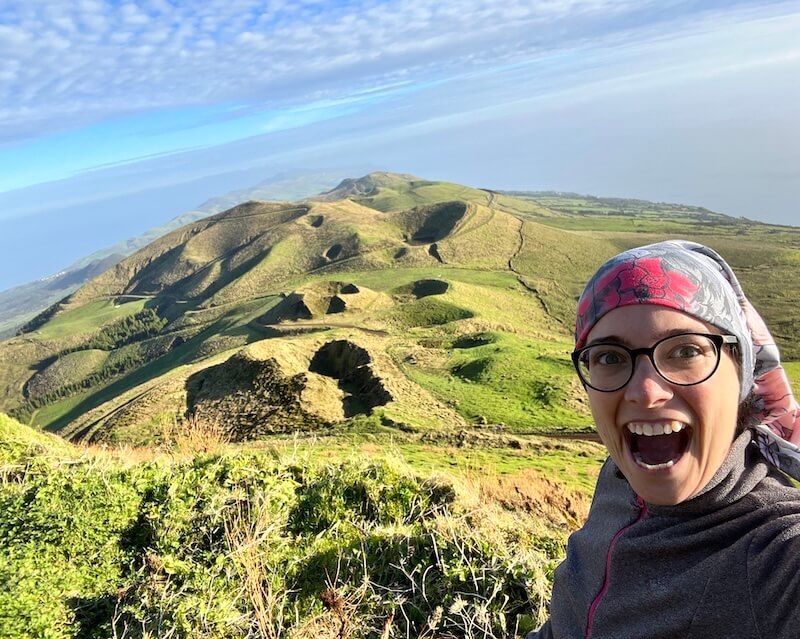
While São Jorge is famous for its dramatic cliffs and fajãs, what really took my breath away was the central ridge of extinct volcanoes running across the island’s spine. You can drive up there (though be warned — the roads are quite narrow), but if you enjoy hiking like I do, there’s really only one way to do this: take the PR4SJO trail.
This route covers the island’s central peaks — including Pico da Esperança, the highest point in São Jorge — and treats you to sweeping views of the ocean on both sides. The trail then winds down through lush pastures, volcanic craters, and forest until you finally reach Fajã do Ouvidor, where the island greets you with a well-earned reward: Poça de Simão Dias, a huge natural saltwater pool carved into the lava rocks.
It’s 17 km long, but surprisingly gentle — so my advice? Pack a picnic, hit the trail in the morning, and spend your afternoon floating in Simão Dias with a goofy grin on your face.
🥾 Want the full breakdown? Check out my guide to the best hikes in São Jorge.
🛏️ Staying a while? Here’s where to stay in São Jorge Island — whether you want mountain views or beachfront breakfasts.
Natural Wonders in Flores Island
If you’re looking for the kind of Azorean beauty that makes you stop mid-step and say “Wait, what?”, Flores is your island. From towering waterfalls to crater lakes and sea-carved caves, it feels like the Azores turned the volume up to 11. It’s smaller and more remote than most other islands, but the payoff is huge — some of the most cinematic natural wonders in the Azores are tucked into every corner.
Poço da Ribeira do Ferreiro
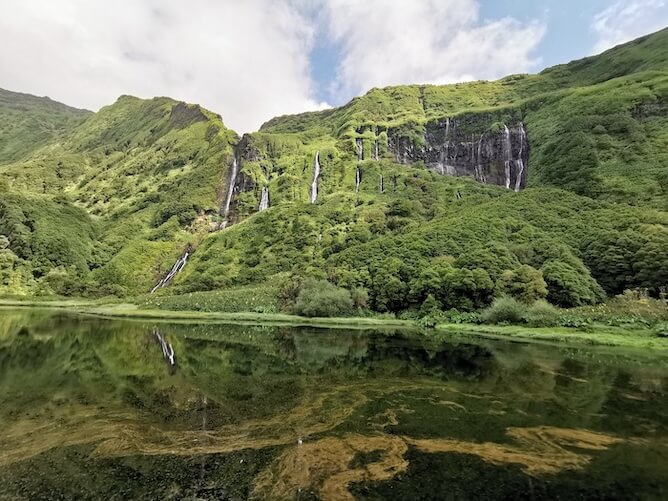
Even if you’ve never been to Flores, you’ve probably seen photos of this place — a lush green wall of cliffs covered in long, ribbon-like waterfalls that seem to tumble from the sky. It’s sometimes called “Alagoinha”, and let me tell you: the photos don’t do it justice.
The walk to get there takes about 20 to 30 minutes each way on a well-maintained trail. It’s roughly 1.2 km (0.75 miles) from the parking area to the viewpoint, with a mostly flat and easy path — though it can get muddy after rain, so bring good shoes.
When you reach the viewpoint, it feels like something out of a Jurassic Park movie. Seriously!
Natural Pools of Santa Cruz das Flores
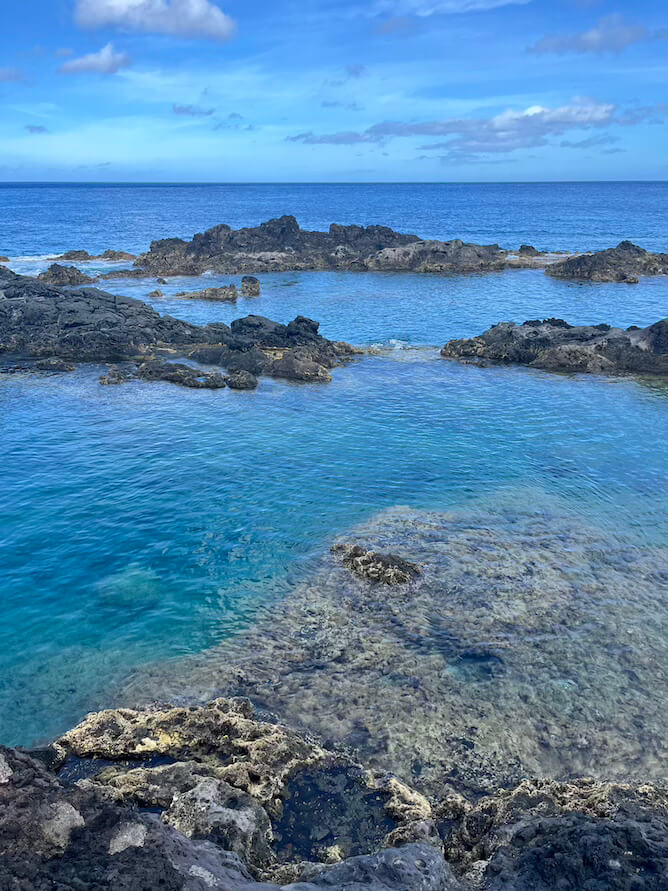
On the opposite end of the hiking spectrum, Flores also rewards you with places where the only effort involved is slipping into your swimsuit. The natural pools in Santa Cruz das Flores are perfect for a relaxing swim, especially after a long hike. Calm, clear, and carved from volcanic rock, they offer the kind of low-key magic that makes you want to stay longer than you planned.
But the real adventure? Take to the sea.
Sea Caves and Waterfalls
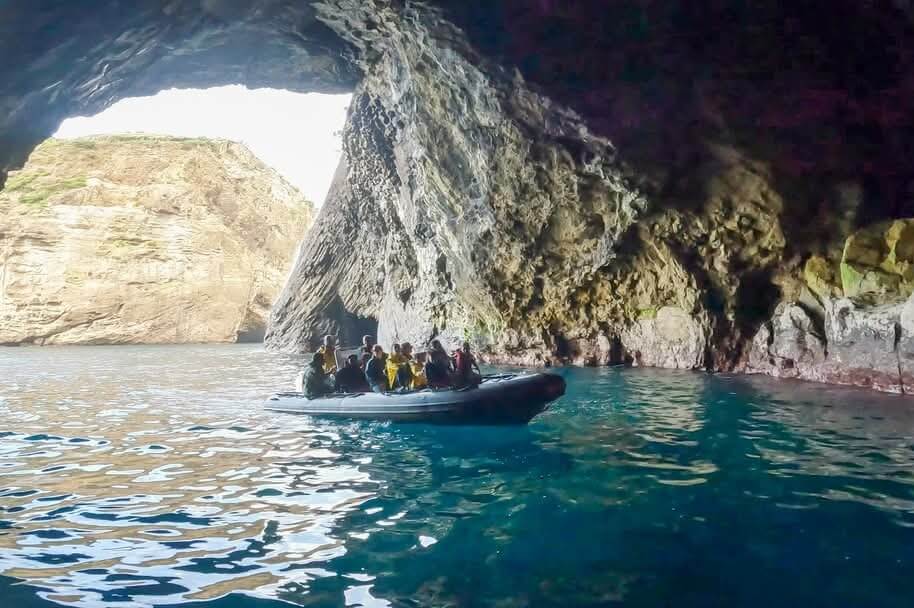
Some of the island’s most dramatic scenery is only visible by boat — sea cliffs towering over the Atlantic, waterfalls plunging straight into the ocean, and hidden caves carved by time and tide. One of my favorite ways to experience this side of Flores is on a small-group boat tour that takes you along the coast with plenty of stops (and stories) along the way.
Trust me: seeing Flores from the water gives you a whole new appreciation for just how wild and vertical this island really is.
👉 Join this boat trip to Flores’ sea caves and waterfalls
🧭 Curious about the island’s UNESCO Biosphere Reserve status? Read more from UNESCO’s official site on why Flores is so ecologically unique.
🛏️ Staying the night (or three)? Here’s where to stay in Flores Island — whether you want clifftop views or cozy village vibes.
Natural Wonders in Corvo Island
Tiny, remote, and full of character — Corvo is the smallest island in the Azores, and for most people, it’s a day trip from Flores. But don’t let the size fool you: this island packs a serious punch when it comes to landscape. If you’re chasing natural wonders in the Azores that feel untouched and genuinely quiet, Corvo delivers.
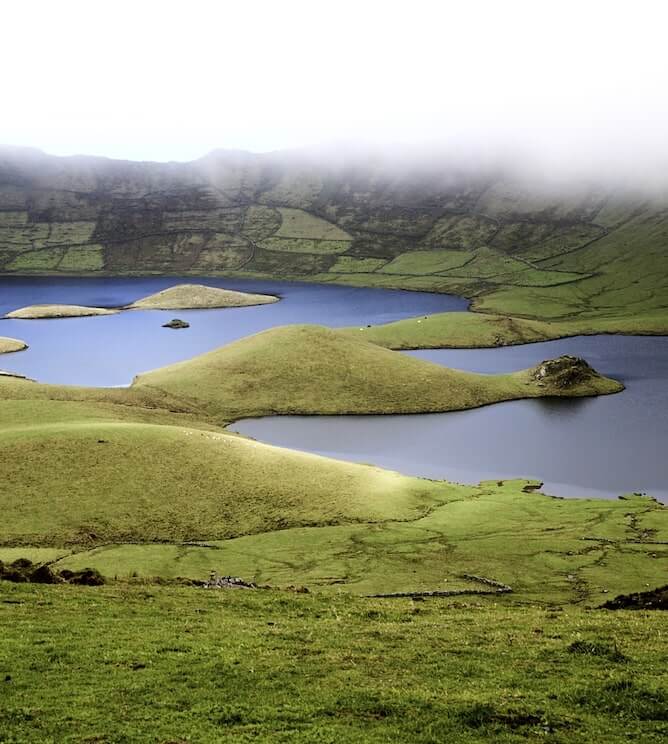
The main event here is Caldeirão, a massive volcanic crater that dominates the center of Corvo and gives you the sense that the whole island is just a floating rim around it. Inside the crater are two little lakes and several small hills — locals like to say they resemble the nine islands of the Azores, though I’ll let you be the judge of that.
You can hike around the rim (weather permitting), which offers spectacular views of both the crater and the Atlantic beyond. If the clouds roll in, don’t be discouraged — the mist often adds to the atmosphere. Just bring a proper windbreaker and you’ll do just fine.
A Perfect Day Trip from Flores
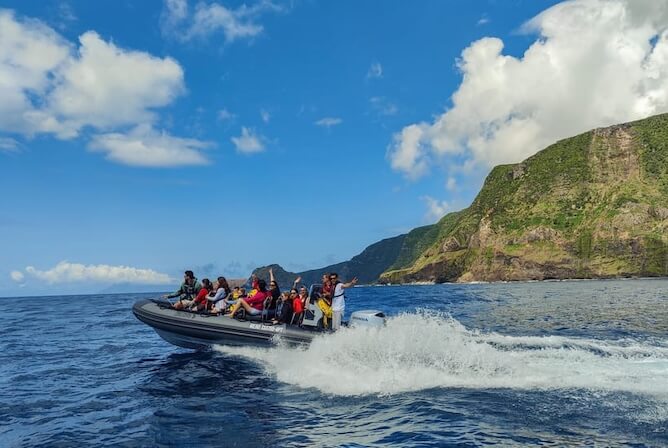
Most visitors come to Corvo on a day trip from Flores, and that’s exactly what I did. The boat ride alone is an adventure — you’ll skirt the cliffs of Flores, maybe spot dolphins or seabirds, and then pull into the tiny port of Vila do Corvo, where time slows down in the best possible way.
The guided tours usually include a 4×4 ride up to the crater, free time in the village, and plenty of stories from locals who’ve lived here their whole lives. It’s low-key, beautiful, and honestly… kind of magical.
👉 Book your boat trip to Corvo and full island tour here
🛏️ Planning to stay the night (because why not)? Here’s where to stay in Corvo Island. Let me warn you though that the island is MINUSCULE, there are only a couple of places available and hence you should book your stay as soon as possible.
Natural wonders in the Azores: Frequently Asked Questions
Are the natural wonders in the Azores kid-friendly?
Quite a few of them are! Places like Sete Cidades, Furnas, and the natural pools in Biscoitos or Santa Cruz das Flores are easy to access and fun for kids. But some activities — like climbing Mount Pico, descending into the Faial caldera, or hiking the 17 km PR4SJO trail in São Jorge — are better left to older children or teens who are used to walking longer distances and can handle steeper terrain.
Do I need to book these activities in advance?
In most cases, yes — especially if you’re visiting between June and September. Whale watching tours, hot springs and any kind of guided hike (like the climb to Mount Pico or the descent into the Faial caldera) are all best booked in advance. These experiences tend to fill up quickly during high season (May to September), and availability is very limited, especially on the smaller islands.
For free attractions like Poço da Ribeira do Ferreiro or the viewpoints at Sete Cidades, no booking is needed. But it’s still worth arriving early to beat the crowds and enjoy a quieter visit.
Are there entry fees for these places?
Some spots do charge a small entrance fee — places like Algar do Carvão, Gruta do Natal, or Caldeira Velha. But most viewpoints, trails, and natural pools are free. The exceptions are climbs or hikes that legally require a guide, like Mount Pico or the descent into Faial’s caldera. These are more expensive, yes, but they’re genuinely unforgettable and well worth the extra cost.
What’s the best time to visit these natural wonders?
May to October is generally the best time. You’ll get mild weather, more stable conditions for hiking, and the full range of tours running. April to June is ideal for whale watching, especially if you want to spot migratory species like blue and fin whales. July through September brings the warmest ocean temperatures and better swimming conditions. October is quieter, which is great if you prefer fewer crowds, but keep an eye on the forecast — the weather is incredibly unpredictable in the Azores islands, and rain is more likely later in the season.

